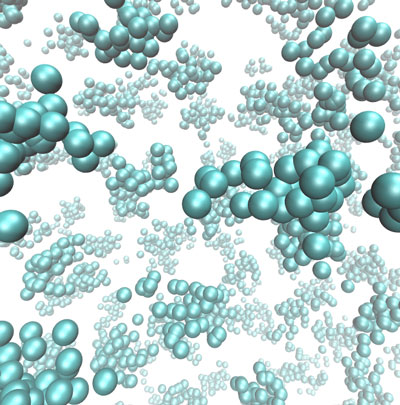| Jul 01, 2013 |
Quantum simulation of low temperature metallic hydrogen
|
|
(Nanowerk News) Theoretical techniques have been used to predict the existence of metallic liquid hydrogen at low temperature and high pressure in a paper published in Nature Communications ("Quantum simulation of low-temperature metallic liquid hydrogen").
|
|
The nature of dense hydrogen is a central problem in physics and its abundance, for example, in gas giants such as Jupiter and Saturn means that it is critical to our understanding of the universe.
|
 |
| A snapshot from the ab-initio path-integral molecular dynamics simulation where a metallic liquid phase is found at 900 GPa and 50 K. In this simulation, the quantum nature of the nuclei is addressed. In contrast, using a conventional treatment with classical nuclei the system solidifies at arround the room temperature. This difference indicates that the quantum nature of the nuclei is essential for this low-temperature metallic phase.
|
|
This study, involving a group of researchers from the Thomas Young Centre at UCL, as well as from Peking University, Cambridge and York, presents a fundamental advance in the understanding of dense hydrogen which has far reaching implications for a wide range of scientific fields.
|
|
In spite of the tremendous progress made over the last 80 years, important gaps in our understanding of the hydrogen phase diagram remain, with arguably the most challenging issue being the solid to liquid melting transition at ultra-high pressures.
|
|
The melting temperature of solid hydrogen is known to fall at high pressures and it had been speculated that a metallic liquid state might exist at low temperatures.
|
|
This study looked at the melting of hydrogen by computer simulation of the coexistence of the solid and liquid phases, for the first time taking the quantum motion of the protons into account explicitly.
|
|
The findings show a low-temperature metallic atomic liquid phase of hydrogen at pressures 900 GPa and above, down to 50K, the lowest temperature that can be reliably simulated. The existence of this low temperature liquid is associated with a negative slope of the melting line between atomic liquid and solid phases at pressures between 500 and 800 GPa.
|
|
These results are highly quantum in nature, with classical simulations demonstrating completely different behaviour, with the simulations showing considerably higher melting points.
|
|
This study confirms the existence of this phase in simulations and shows how the quantum motion of the protons plays a critical role in its stabilisation.
|
|
Professor Xinzheng Li, lead author of the paper, said “"It's very exciting that computational techniques based on quantum mechanics have reached such a state of maturity that reliable predictions about the properties of hydrogen at these extreme pressures can now be made. All we need now is for experiment to catch up and provide support for our predictions!"
|

